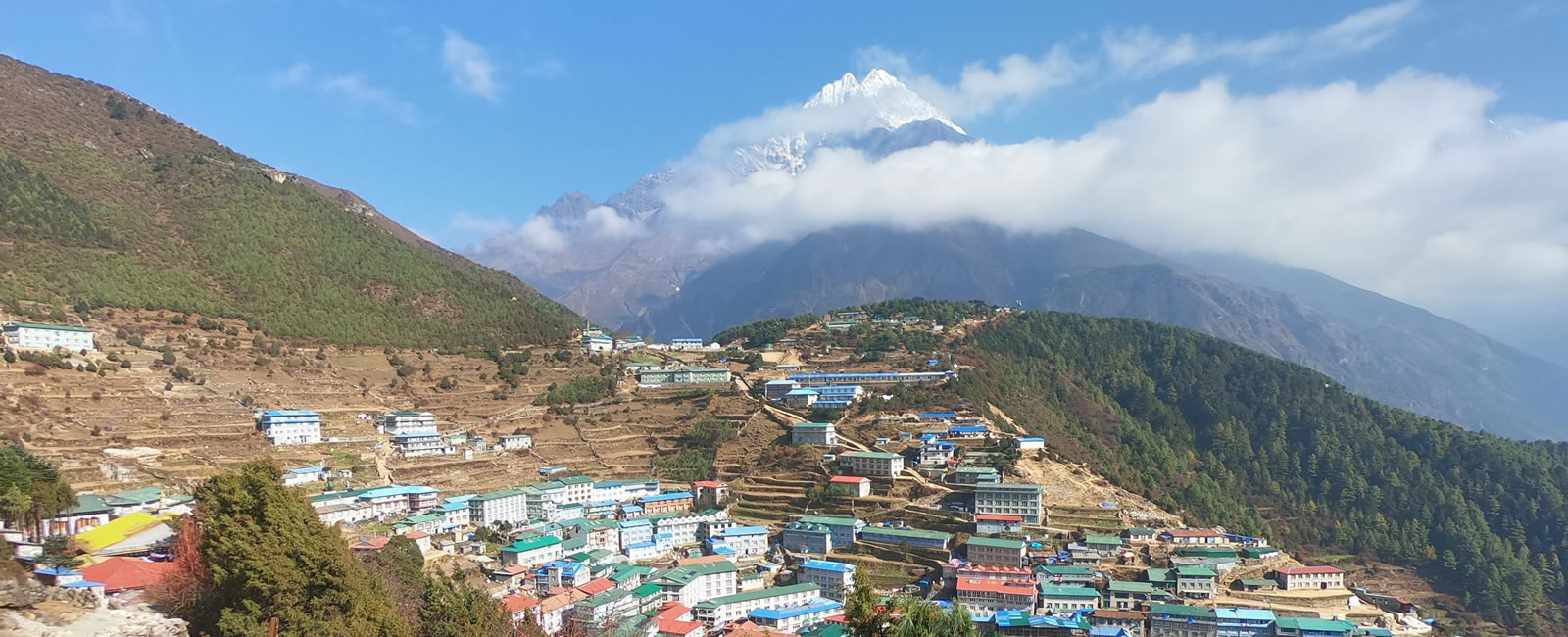
Trekking in Nepal in May offers chances to see mountaineers' expedition in action. It is a transition month from spring to summer. Characterizing as a relatively warm and more stable weather condition even in the high altitudes of Nepal which becomes a favorable time for all treks in Nepal.
Most of the trekking trails are filled with red and pink flowers and brown leaves that have just fall from the trees. That majestic sensation as you walk above the spring flowers is the best feeling in the world. With a bit close to summer, you get to witness the greenery of pre-monsoon as well as the remaining beauty of May.
Rhododendron blooms can be witnessed on both sides of the trekking routes along with awe-inspiring sceneries of diverse flora and fauna and lustrous greeneries all around.
In the late afternoons, the weather may get cloudy causing plenty of thunderstorms and occasional rainfall. It will be beneficial to be well prepared to have proper rain gears.
For Trekking in Nepal in May, numerous destinations are available, you might get confused about choosing the right destination. This month is taken the perfect month for trekking in the Himalayan foothills and mountaineering in the elevated peaks.
The humidity gets high during this month, you need to be well prepared and well equipped for trekking in the foothills with ease. An average temperature reaches up to 25+ degree Celsius in the daytime and it decreases up to 5-6 degrees Celsius in the nights and early mornings which is ideal for trekking.
Quite longer days, stable weather atmosphere, warmer climate causing humidity are some of the characteristics of trekking in Nepal in May. Expect around 20-25 degrees Celsius in the daytime whereas 5-8 degrees Centigrade in the night during your trip.
The weather and climatic conditions may fluctuate according to the elevations. You can enjoy mild and warm weather in the lower regions of the trek.
Below 2000m in the hills and valleys of Nepal, you can enjoy day temperatures of 20-32 degrees Celsius. At altitudes between 2000m to 5000m, you can enjoy moderate weather.
Here, the day temperatures are warm at 12 to 20+ degrees Celsius. The temperatures hardly drop to zero or negative degrees even during the nights.
Ascending higher, the temperature decreases hardly to zero or negative degrees even during the nights. Similarly, there are variations depending on the trek.
Sometimes, the passes and base camps have more extreme conditions due to avalanches. The high passes are generally snow-free. You get clear and superb views of glittering peaks during this month.
Trip Duration: 14-16 days
Max Altitude: Kala Pathar- 5,545m (18,192ft)
Trip Difficulty: Moderate
Permits Needed: Sagarmatha National Park Entry Permit and Khumbu Pasang Lhamu Rural Municipality Entrance Permit
Highlights
Trip Duration: 9-16 days
Max Altitude: ABC- 4,130m/13,550 feet
Trip Difficulty: Moderate
Permits Needed: Trekkers’ Information Management Systems (TIMS) and Annapurna Conservation Area Project (ACAP)
Highlights
Trip Duration: 14-21 days
Max Altitude: Thorong La- 5416m (18,192ft)
Trip Difficulty: Moderate
Permits Needed: Trekkers’ Information Management Systems (TIMS) and Annapurna Conservation Area Project (ACAP)
Trip Duration: 8-12 Days
Max Altitude: Kyangjin Ri-4,773m/15,659ft
Trip Difficulty: Moderate
Permits Needed: National Park entry ticket, and Trekker’s Information Management System (TIMS)
Highlights
Trip Duration: 7-10 Days
Max Altitude: Poonhill 3210m/10,531ft
Trip Difficulty: Easy to Moderate
Permits Needed: Annapurna Conservation Area Project (ACAP) and Trekker’s Information Management System (TIMS)
Highlights
Trip Duration: 17-24 days
Max Altitude: Larke La Pass- 5,213m/17,103ft
Trip Difficulty: Moderate to Strenuous
Permits Needed: Manaslu Conservation Area Project (MCAP Permit), Annapurna Conservation Area Project (ACAP Permit), and Special Restricted Area Permit for Manaslu (Manaslu RAP)
Highlights
Trip Duration: 16-18 days
Max Altitude: Upper Mustang- 4,210m/13,812ft
Trip Difficulty: Moderate
Permits Needed: Upper Mustang Restricted Area Permit (RAP) and Annapurna Conservation Area Project (ACAP)
Highlights
Trip Duration: 14-16 days
Max Altitude: Gokyo Ri-5,357m/17,570ft
Trip Difficulty: Moderate
Permits Needed: Sagarmatha National Park Entry Permit and Khumbu Pasang Lhamu Rural Municipality Entrance Permit
Highlights
Trip Duration: 25-27 days
Max Altitude: Kang La Pass-5,151m/16,900ft
Trip Difficulty: Challenging
Permits Needed: Restricted region permit and Shey Phoksundo National Park entry Permit
Highlights
Trip Duration: 21-30 days
Max Altitude: Kala Pathar- 5200m/1,7060ft
Trip Difficulty: Strenuous
Permits Needed: Kanchenjunga National Park Permit and Kanchenjunga Restricted Area Permit
Highlights
Trip Duration: 10-12 days
Max Altitude: Mardi Himal Base Camp (West) (4,500m/ 14,763ft)
Trip Difficulty: Moderate
Permits Needed: Trekkers Information Management System (TIMS Card) and Annapurna Conservation Area Project (ACAP)
Highlights
While Trekking in Nepal in May, most of the teahouses get opened and lodges are in full operation. Throughout the trekking trails, trekkers can accommodate and eat in the teahouses established at every stop.
Due to the heavy flock of tourists, you may get difficulties getting the rooms in the higher elevations. In such a case, you may need to share the room with the next tour as well. A pre-booking room makes your journey more comfortable.
May is one of the busiest months for trekking in Nepal that offers a pleasant weather atmosphere, favorable climatic conditions, and atmosphere.
Lustrous greeneries, diversified landscapes, and topographies changed geographical circumstances, mighty snow-capped peaks, tranquil surroundings, green rolling hills, cerulean lakes, and milky river makes your trekking in May more enjoyable and memorable.
Leave Your Comment